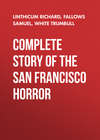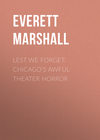Читать книгу: «Complete Story of the San Francisco Horror», страница 3
CHAPTER III.
THIRD DAY ADDS TO HORROR
Fire Spreads North and South Attended by Many Spectacular Features – Heroic Work of Soldiers Under General Funston – Explosions of Gas Add to General Terror.
THE third day of the fire was attended by many spectacular features, many scenes of disaster and many acts of daring heroism.
When night came the fire was raging over fifty acres of the water front lying between Bay street and the end of Meiggs and Fisherman’s wharf. To the eastward it extended down to the sea wall, but had not reached the piers, which lay a quarter of a mile toward the east.
The cannery and warehouses of the Central California Canneries Company, together with 20,000 cases of canned fruit, was totally destroyed, as also was the Simpson and other lumber companies’ yards.
The flames reached the tanks of the San Francisco Gas Company, which had previously been pumped out, and had burned the ends of the grain sheds, five in number, which extended further out toward the point.
Flame and smoke hid from view the vessels that lay off shore vainly attempting to check the fire. No water was available except from the waterside and it was not until almost dark that the department was able to turn its attention to this point.
At dusk the fire had been checked at Van Ness avenue and Filbert street. The buildings on a high slope between Van Ness and Polk, Union and Filbert streets were blazing fiercely, fanned by a high wind, but the blocks were so sparsely settled that the fire had but a slender chance of crossing Van Ness at that point.
Mayor Schmitz, who directed operations at that point, conferred with the military authorities and decided that it was not necessary to dynamite the buildings on the west side of Van Ness. As much of the fire department as could be collected was assembled to make a stand at that point.
To add to the horrors of the general situation and the general alarm of many people who ascribed the cause of the subterranean trouble to another convulsion of nature, explosions of sewer gas have ribboned and ribbed many streets. A Vesuvius in miniature was created by such an upheaval at Bryant and Eighth streets. Cobblestones were hurled twenty feet upward and dirt vomited out of the ground. This situation added to the calamity, as it was feared the sewer gas would breed disease.
Thousands were roaming the streets famishing for food and water and while supplies were coming in by the train loads the system of distribution was not in complete working order.
Many thousands had not tasted food or water for two and three days. They were on the verge of starvation.
The flames were checked north of Telegraph hill, the western boundary being along Franklin street and California street southeast to Market street. The firemen checked the advance of flames by dynamiting two large residences and then backfiring. Many times before had the firemen made such an effort, but always previously had they met defeat.
But success at that hour meant little for San Francisco.
The flames still burned fitfully about the city, but the spread of fire had been checked.
A three-story lodging house at Fifth and Minna streets collapsed and over seventy-five dead bodies were taken out. There were at least fifty other dead bodies exposed. This building was one of the first to take fire on Fifth street. At least 100 people were lost in the Cosmopolitan on Fourth street.
The only building standing between Mission, Howard, East and Stewart streets was the San Pablo hotel. The shot tower at First and Howard streets was gone. This landmark was built forty years ago. The Risdon Iron works were partially destroyed. The Great Western Smelting and Refining works escaped damages, also the Mutual Electric Light works, with slight damage to the American Rubber Company, Vietagas Engine Company, Folger Brothers’ coffee and spice house was also uninjured and the firm gave away large quantities of bread and milk.
Over 150 people were lost in the Brunswick hotel, Seventh and Mission streets.
The soldiers who rendered such heroic aid took the cue from General Funston. He had not slept. He was the real ruler of San Francisco. All the military tents available were set up in the Presidio and the troops were turned out of the barracks to bivouac on the ground.
In the shelter tents they placed first the sick, second the more delicate of the women, and third, the nursing mothers, and in the afternoon he ordered all the dead buried at once in a temporary cemetery in the Presidio grounds. The recovered bodies were carted about the city ahead of the flames.
Many lay in the city morgue until the fire reached that; then it was Portsmouth square until it grew too hot; afterwards they were taken to the Presidio. There was another stream of bodies which had lain in Mechanics’ pavilion at first, and had then been laid out in Columbia square, in the heart of a district devastated first by the earthquake and then by fire.
The condition of the bodies was becoming a great danger. Yet the troops had no men to spare to dig graves, and the young and able bodied men were mainly fighting on the fire line or utterly exhausted.
It was Funston who ordered that the old men and the weaklings should take this work in hand. They did it willingly enough, but had they refused the troops on guard would have forced them. It was ruled that every man physically capable of handling a spade or a pick should dig for an hour. When the first shallow graves were ready the men, under the direction of the troops, lowered the bodies several in a grave, and a strange burial began.
The women gathered about crying; many of them knelt while a Catholic priest read the burial service and pronounced absolution. All the afternoon this went on.
Representatives of the city authorities took the names of as many of the dead as could be identified and the descriptions of the others. Many, of course, will never be identified.
So confident were the authorities that they had the situation in control at the end of the third day that Mayor Schmitz issued the following proclamation:
“To the Citizens of San Francisco: The fire is now under control and all danger is passed. The only fear is that other fires may start should the people build fires in their stoves and I therefore warn all citizens not to build fires in their homes until the chimneys have been inspected and repaired properly. All citizens are urged to discountenance the building of fires. I congratulate the citizens of San Francisco upon the fortitude they have displayed and I urge upon them the necessity of aiding the authorities in the work of relieving the destitute and suffering. For the relief of those persons who are encamped in the various sections of the city everything possible is being done. In Golden Gate park, where there are approximately 200,000 homeless persons, relief stations have been established. The Spring Valley Water Company has informed me that the Mission district will be supplied with water this afternoon, between 10,000 and 12,000 gallons daily being available. Lake Merced will be taken by the federal troops and that supply protected.
“Eugene E. Schmitz, Mayor.”
Although the third day of San Francisco’s desolation dawned with hope, it ended in despair.
In the early hours of the day the flames, which had raged for thirty-six hours, seemed to be checked.
Then late in the afternoon a fierce gale of wind from the northwest set in and by 7 o’clock the conflagration, with its energy restored, was sweeping over fifty acres of the water front.
The darkness and the wind, which at times amounted to a gale, added fresh terrors to the situation. The authorities considered conditions so grave that it was decided to swear in immediately 1,000 special policemen armed with rifles furnished by the federal government.
In addition to this force, companies of the national guard arrived from many interior points.
In the forenoon, when it was believed the fire had been checked, the full extent of the destitution and suffering of the people was seen for the first time in near perspective. While the whole city was burning there was no thought of food or shelter, death, injury, privation, or loss. The dead were left unburied and the living were left to find food and a place to sleep where they could.
On the morning of the third day, however, the indescribable destitution and suffering were borne in upon the authorities with crushing force. Dawn found a line of men, women, and children, numbering thousands, awaiting morsels of food at the street bakeries. The police and military were present in force, and each person was allowed only one loaf.
A big bakery was started early in the morning in the outskirts of the city, with the announcement that it would turn out 50,000 loaves of bread before night. The news spread and thousands of hungry persons crowded before its doors before the first deliveries were hot from the oven. Here again police and soldiers kept order and permitted each person to take only one loaf. The loaves were given out without cost.
These precautions were necessary, for earlier in the day bread had sold as high as $1 a loaf and two loaves and a can of sardines brought in one instance $3.50.
Mayor Schmitz took prompt and drastic steps to stop this extortion. By his order all grocery and provision stores in the outlying districts which had escaped the flames were entered by the police and their goods confiscated.
Next to the need for food there was a cry for water, which until Friday morning the authorities could not answer.
In spite of all efforts to relieve distress there was indescribable suffering.
Women and children who had comfortable, happy homes a few days before slept that night – if sleep came at all – on hay on the wharves, on the sand lots near North beach, some of them under the little tents made of sheeting, which poorly protected them from the chilling ocean winds. The people in the parks were better provided in the matter of shelter, for they left their homes better prepared.
Thousands of members of families were separated, ignorant of one another’s whereabouts and without means of ascertaining. The police on Friday opened up a bureau of registration to bring relatives together.
The work of burying the dead was begun Friday for the first time. Out at the Presidio soldiers pressed into service all men who came near and forced them to labor at burying the dead. So thick were the corpses piled up that they were becoming a menace, and early in the day the order was issued to bury them at any cost. The soldiers were needed for other work, so, at the point of rifles, the citizens were compelled to take the work of burying. Some objected at first, but the troops stood no trifling, and every man who came in reach was forced to work at least one hour. Rich men who had never done such work labored by the side of the workingmen digging trenches in the sand for the sepulcher of those who fell in the awful calamity. At the present writing many still remain unburied and the soldiers are still pressing men into service.
The Folsom street dock was turned into a temporary hospital, the harbor hospital being unable to accommodate all the injured who were brought there.
About 100 patients were stretched on the dock at one time. In the evening tugs conveyed them to Goat Island, where they were lodged in the hospital. The docks from Howard street to Folsom street had been saved, and the fire at this point was not permitted to creep farther east than Main street.
The work of clearing up the wrecked city has already begun at the water front in the business section of the town. A force of 100 men were employed under the direction of the street department clearing up the debris and putting the streets in proper condition.
It was impossible to secure a vehicle except at extortionate prices. One merchant engaged a teamster and horse and wagon, agreeing to pay $50 an hour. Charges of $20 for carrying trunks a few blocks were common. The police and military seized teams wherever they required them, their wishes being enforced at revolver point if the owner proved indisposed to comply with the demands.
Up and down the broad avenues of the parks the troops patrolled, keeping order. This was difficult at times, for the second hysterical stage had succeeded the paralysis of the first day and people were doing strange things. A man, running half naked, tearing at his clothes, and crying, “The end of all things has come!” was caught by the soldiers and placed under arrest.
Under a tree on the broad lawn of the children’s playground a baby was born. By good luck there was a doctor there, and the women helped out, so that the mother appeared to be safe. They carried her later to the children’s building in the park and did their best to make her comfortable.
All night wagons mounted with barrels and guarded by soldiers drove through the park doling out water. There was always a crush about these wagons and but one drink was allowed to a person.
Separate supplies were sent to the sick in the tents. The troops allowed no camp fires, fearing that the trees of the park might catch and drive the people out of this refuge to the open and windswept sands by the ocean.
The wind which had saved the heights came cold across the park, driving a damp fog, and for those who had no blankets it was a terrible night, for many of them were exhausted and must sleep, even in the cold. They threw themselves down in the wet grass and fell asleep.
When the morning came the people even prepared to make the camp permanent. An ingenious man hung up before his little blanket shelter a sign on a stick giving his name and address before the fire wiped him out. This became a fashion, and it was taken to mean that the space was preempted.
Toward midnight a black, staggering body of men began to weave through the entrance. They were volunteer fire fighters, looking for a place to throw themselves down and sleep. These men dropped out all along the line and were rolled out of the driveways by the troops.
There was much splendid unselfishness there. Women gave up their blankets and sat up or walked about all night to cover exhausted men who had fought fire until there was no more fight in them.
CHAPTER IV.
TWENTY SQUARE MILES OF WRECK AND RUIN
Fierce Battle to Save the Famous Ferry Station, the Chief Inlet to and Egress from San Francisco – Fire Tugs and Vessels in the Bay Aid in Heroic Fight – Fort Mason, General Funston’s Temporary Headquarters, has Narrow Escape – A Survey of the Scene of Desolation.
WHEN darkness fell over the desolate city at the end of the fourth day of terror, the heroic men who had borne the burden of the fight with the flames breathed their first sigh of relief, for what remained of the proud metropolis of the Pacific coast was safe.
This was but a semi-circular fringe, however, for San Francisco was a city desolate with twenty square miles of its best area in ashes. In that blackened territory lay the ruins of sixty thousand buildings, once worth many millions of dollars and containing many millions more.
The fourth and last day of the world’s greatest conflagration had been one of dire calamity and in some respects was the most spectacular of all. On the evening of the third day (Friday) a gale swept over the city from the west, fanned the glowing embers into fierce flames and again started them upon a path of terrible destruction.
The fire which had practically burnt itself out north of Telegraph Hill was revived by the wind and bursting into a blaze crept toward the East, threatening the destruction of the entire water front, including the Union ferry depot, the only means of egress from the devastated city.
The weary firemen still at work in other quarters of the city were hastily summoned to combat the new danger. Hundreds of sailors from United States warships and hundreds of soldiers joined in the battle, and from midnight until dawn men fought fire as never fire had been fought before. Fire tugs drew up along the water front and threw immense streams of water on to the flames of burning factories, warehouses and sheds.
Blocks of buildings were blown up with powder, guncotton, and dynamite, or torn down by men armed with axes and ropes. All night long the struggle continued. Mayor Schmitz and Chief of Police Dinan, although without sleep for forty-eight hours, remained on the scene all night to assist army and navy officers in directing the fight.
At 7 o’clock Saturday morning, April 21, the battle was won. At that hour the fire was burning grain sheds on the water front about half a mile north of the Ferry station, but was confined to a comparatively small area, and with the work of the fireboats on the bay and the firemen on shore, who were using salt water pumped from the bay, prevented the flames from reaching the Ferry building and the docks in that immediate vicinity.
On the north beach the fire did not reach that part of the water front lying west of the foot of Powell street. The fire on the water front was the only one burning. The entire western addition to the city lying west of Van Ness avenue, which escaped the sweep of flame on Friday, was absolutely safe.
Forty carloads of supplies, which had been run upon the belt line tracks near one of the burned wharves, were destroyed during the night.
A survey of the water front Saturday morning showed that everything except four docks had been swept clean from Fisherman’s wharf, at the foot of Powell street, to a point around westerly, almost to the Ferry building.
This means that nearly a mile of grain sheds, docks and wharves were added to the general destruction. In the section north of Market street the ruined district was practically bounded on the west by Van Ness avenue, although in many blocks the flames destroyed squares to the west of that thoroughfare. The Van Ness avenue burned line runs northerly to Greenwich street, which is a few blocks from the bay. Then the boundary was up over Telegraph Hill and down to that portion of the shore that faces Oakland. Practically everything included between Market, Van Ness avenue, Greenwich, and the bay was in ashes.
On the east side of Hyde street hill the fire burned down to Bay street and Montgomery avenue and stopped at that intersection.
Fort Mason was saved only by the most strenuous efforts of soldiers and firemen. It stands just north of the edge of the burned district, the flames having been checked only three blocks away at Greenwich street.
All south of Market street except in the vicinity of the Pacific Mail dock, was gone. This section is bounded on the north by Market street and runs out to Guerrero street, goes out that street two blocks, turns west to Dolores, runs west six blocks to about Twenty-second, taking in four blocks on the other side of Dolores. The fire then took an irregular course southward, spreading out as far as Twenty-fifth street and went down that way to the southerly bay shore.
Maj. C. A. Devol, depot quartermaster and superintendent of the transport service, graphically described the conquering of the fire on the water front, in which he played an important part:
“This fire, which ate its way down to the water front early Friday afternoon, was the climax of the whole situation.
“We realized at once that were the water front to go, San Francisco would be shut off from the world, thus paralyzing all transportation faculties for bringing in food and water to the thousands of refugees huddled on the hillsides from Fort Mason to Golden Gate Park. It would have been impossible to either come in or go out of the city save by row boats and floats, or by the blocked passage overland southward.
“This all-important section of the city first broke into flames in a hollow near Meiggs wharf, about 2 o’clock in the afternoon. The tugs of our service were all busy transporting provisions from Oakland, but the gravity of the situation made it necessary for all of them to turn to fire-fighting.
“The flames ate down into the extensive lumber district, but had not caught the dock line. Behind the dock, adjacent to the Spreckels sugar warehouse and wharf, were hundreds of freight cars. Had these been allowed to catch fire, the flames would have swept down the entire water front to South San Francisco.
“The climax came at Pier No. 9, and it was here that all energies were focused. A large tug from Mare Island, two fire patrol boats, the Spreckels tugs and ten or twelve more, had lines of hose laid into the heart of the roaring furnace and were pumping from the bay to the limit of their capacities.
“About 5 o’clock I was told that the tugs were just about holding their own and that more help would be needed. The Slocum and the McDowell were at once ordered to the spot. I was on board the former and at one time the heat of the fire was so great that it was necessary to play minor streams on the cabin and sides of the vessel to keep it from taking fire. We were in a slip surrounded by flames.
“Our lines of hose once laid to the dockage, we found willing hands of volunteers waiting to carry the hose forward. I saw pale, hungry men, who probably had not slept for two days, hang on to the nozzle and play the stream until they fell from exhaustion. Others took their places and only with a very few exceptions was it necessary to use force to command the assistance of citizens or onlookers.
“All night the flames raged through the lumber district, and the fire reached its worst about 3:30 o’clock Saturday morning. Daylight found it under control.”
All that was left of the proud Argonaut city was like a Crescent moon set about a black disk of shadow. A Saharan desolation of blackened, ash covered, twisted debris was all that remained of three-fifths of the city that four days ago stood like a sentinel in glittering, jeweled armor, guarding the Golden Gate to the Pacific.
Men who had numbered their fortunes in the tens of thousands camped on the ruins of their homes, eating as primitive men ate – gnawing; thinking as primitive men thought. Ashes and the dull pain of despair were their portions. They did not have the volition to help themselves, childlike as the men of the stone age, they awaited quiescent what the next hour might bring them.
Fear they had none, because they had known the shape of fear for forty-eight hours and to them it had no more terrors. Men overworked to the breaking point and women unnerved by hysteria dropped down on the cooling ashes and slept where they lay, for had they not seen the tall steel skyscrapers burn like a torch? Had they not beheld the cataracts of flame fleeting unhindered up the broad avenues, and over the solid blocks of the city?
Fire had become a commonplace. Fear of fire had been blunted by their terrible suffering, and although the soldiers roused the sleepers and warned them against possible approaching flames, they would only yawn, wrap their blanket about them and stolidly move on to find some other place where they might drop and again slumber like men dead.
As the work of clearing away the debris progressed it was found that an overwhelming portion of the fatalities occurred in the cheap rooming house section of the city, where the frail hotels were crowded at the time of the catastrophe.
In one of these hotels alone, the five-story Brunswick rooming-house at Sixth and Howard streets, it is believed that 300 people perished. The building had 300 rooms filled with guests. It collapsed to the ground entirely and fire started amidst the ruins scarcely five minutes later.
South of Market street, where the loss of life was greatest, was located many cheap and crowded lodging houses. Among others the caving in of the Royal, corner Fourth and Minna streets, added to the horror of the situation by the shrieks of its many scores of victims imbedded in the ruins.
The collapsing of the Porter House on Sixth street, between Mission and Market, came about in a similar manner. Fully sixty persons were entombed midst the crash. Many of these were saved before the fire eventually crept to the scene.
Part of the large Cosmopolitan House, corner Fifth and Mission streets, collapsed at the very first tremble. Many of the sleepers were buried in the ruins; other escaped in their night clothes.
At 775 Mission street the Wilson House, with its four stories and eighty rooms, fell to the ground a mass of ruins. As far as known very few of the inmates were rescued.
The Denver House on lower Third street, with its many rooms, shared the same fate and none may ever know how many were killed, the majority of the inmates being strangers.
A small two-story frame building occupied by a man and wife at 405 Jessie street collapsed without an instant’s warning. Both were killed.
To the north of Market street the rooming-house people fared somewhat better. The Luxemburg, corner of Stockton and O’Farrell streets, a three-story affair, suffered severely from the falling of many tons of brick from an adjoining building. The falling mass crashed through the building, killing a man and woman.
At the Sutter street Turkish baths a brick chimney toppled over and crashing through the roof killed one of the occupants as he lay on a cot. Another close by, lying on another cot, escaped.
Two hundred bodies were found in the Potrero district, south of Shannon street in the vicinity of the Union Iron works, were cremated at the Six-Mile House, on Sunday by the order of Coroner Walsh. Some of the dead were the victims of falling buildings from the earthquake shock, some were killed in the fire.
So many dead were found in this limited area that cremation was deemed absolutely necessary to prevent disease. The names of some of the dead were learned, but in the majority of cases identification was impossible owing to the mutilation of the features.
A systematic search for bodies of the victims of the earthquake and fire was made by the coroner and the state board of health inspectors as soon as the ruins cooled sufficiently to permit a search.
The body of an infant was found in the center of Union street, near Dupont street.
Three bodies were found in the ruins of the house on Harrison street between First and Second streets. They had been burned beyond all possibility of identification. They were buried on the north beach at the foot of Van Ness avenue.
The body of a man was found in the middle of Silver street, between Third and Fourth streets. A bit of burned envelope was found in the pocket of the vest bearing the name “A. Houston.”
The total number of bodies recovered and buried up to Sunday night was 500. No complete record can ever be obtained as many bodies were buried without permits from the coroner and the board of health.
Whenever a body was found it was buried immediately without any formality whatever and, as these burials were made at widely separated parts of the city by different bodies of searchers, who did not even make a prompt report to headquarters, considerable confusion resulted in estimating the number of casualties and exaggerated reports resulted.















